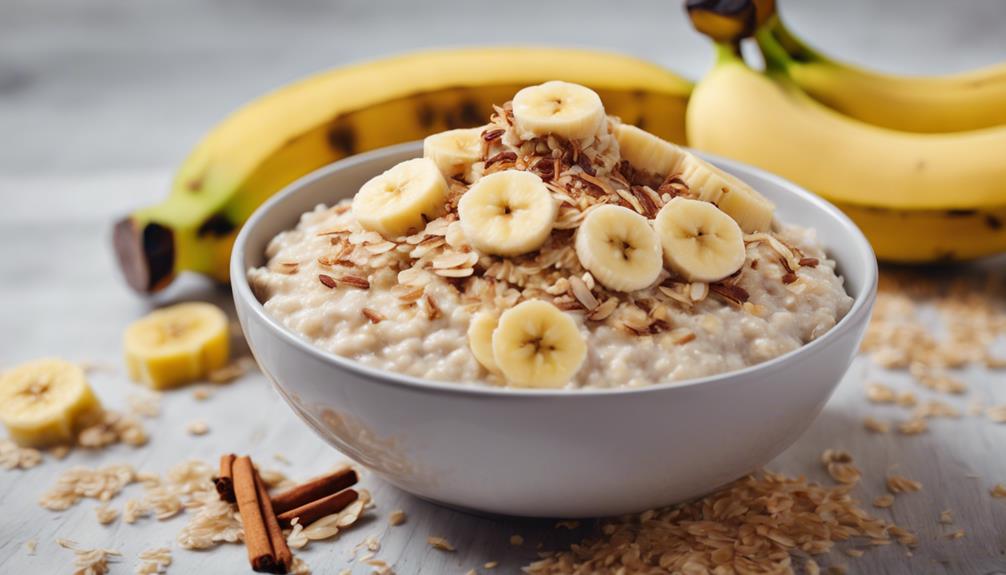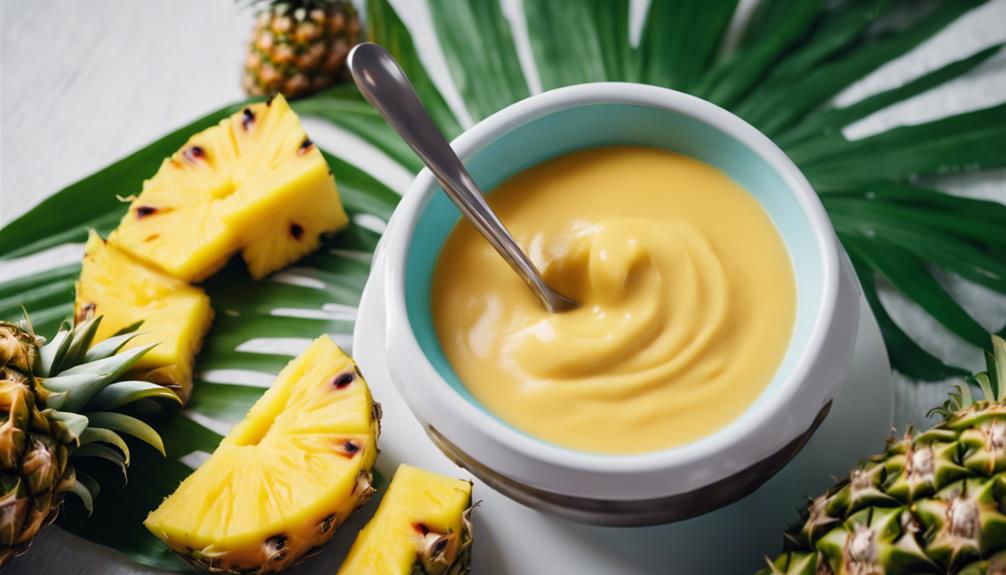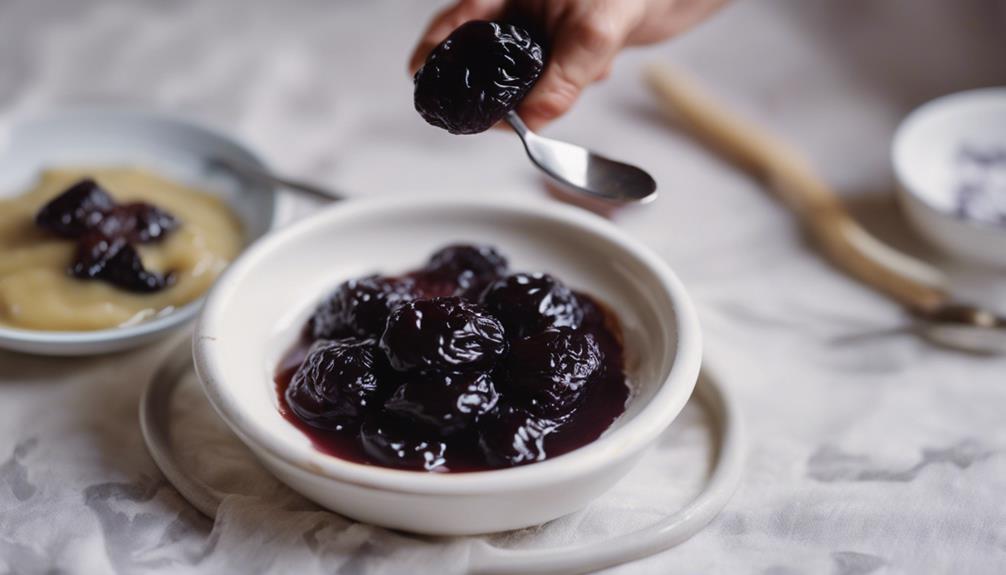When preparing applesauce for toddlers, choose Granny Smith for a tangy taste, Pink Lady for sweetness, or Cortland and Jonathan for balanced flavors. Mix them for complex taste. Add water, lemon juice for sweetness, strawberries for tartness, cinnamon, and vanilla extract for aroma. Peel, core, chop apples, simmer with flavorings, mash or blend. Adjust consistency. Serve warm or chilled, store extras in fridge or freezer. Pair applesauce with dishes or snacks, experiment with flavors, and offer warm or cold. Homemade applesauce benefits toddlers with fiber for digestion, Vitamin C for immunity, and essential nutrients for growth. Varied apples and flavors enhance taste.
Key Takeaways
- Mix apple varieties for a complex flavor profile toddlers will enjoy.
- Add lemon juice for natural sweetness without added sugars.
- Experiment with cinnamon or vanilla extract for added aroma.
- Ensure applesauce is soft and easy for toddlers to eat.
- Store leftovers in the fridge or freezer for quick and healthy snacks.
Best Apples for Homemade Applesauce
When making homemade applesauce for toddlers, selecting the best apples is essential for a delicious and nutritious treat. Granny Smith apples offer a tangy tartness that adds an invigorating kick to the applesauce, appealing to toddlers who enjoy a bit of zing in their snacks.
On the other hand, Pink Lady apples bring a natural sweetness that balances out the flavors, making the applesauce more palatable for young taste buds. Cortland and Jonathan apples are versatile choices that provide a well-rounded flavor profile suitable for chunky or smooth textures, catering to different toddler preferences.
Ingredients and Flavor Enhancers
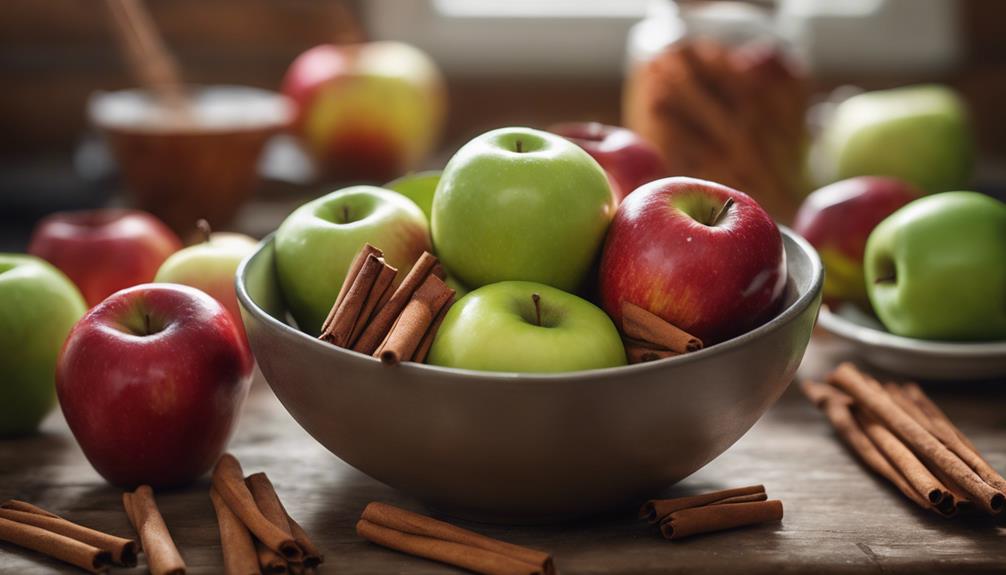
Consider incorporating various ingredients and flavor enhancers to enhance the taste of your homemade applesauce for toddlers. Start with a mix of apple varieties like Pink Lady, Fuji, Honeycrisp, or Sweet Tango to create a complex flavor profile.
When cooking the apples, adding water helps soften them for blending. While lemon juice isn't essential, it can elevate the natural sweetness of the apples.
For added flair, try mixing in strawberries for a hint of tartness or peaches for a sweeter twist. Enhance the aroma by sprinkling in cinnamon and a dash of vanilla extract.
If you prefer a sweeter taste, maple syrup is a great natural sweetener option. Experiment with different combinations of these ingredients to find the perfect balance that your toddler will love.
Step-by-Step Instructions for Making Applesauce
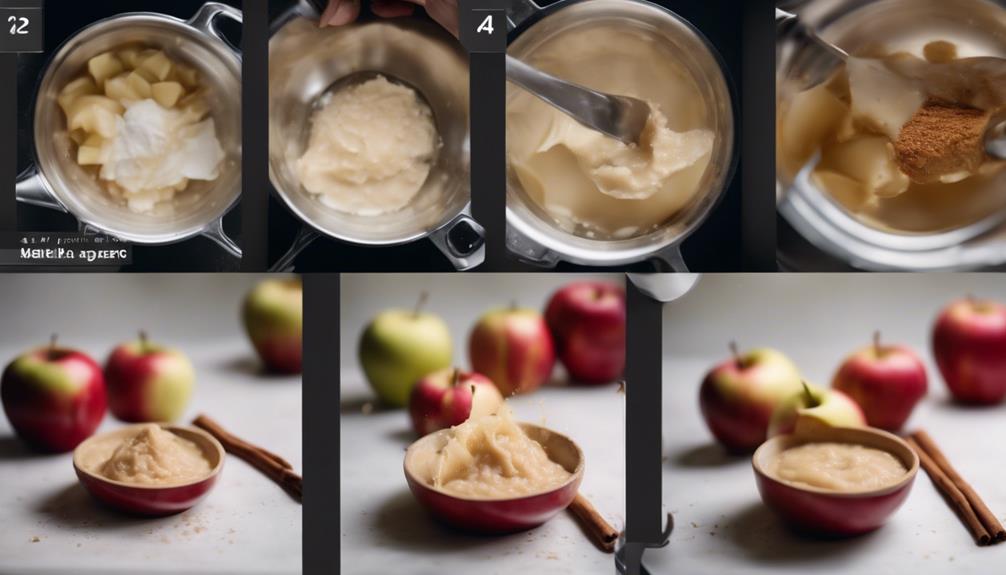
To make applesauce, start by peeling, coring, and chopping apples into bite-sized pieces.
Simmer the apples with a splash of water and any desired flavor enhancers like cinnamon or lemon juice.
Recipe Instructions
Begin by peeling, coring, and chopping the apples into bite-sized pieces for easy cooking. Simmer the prepared apples with water in a pot over medium heat. Add optional flavorings like fresh lemon juice or cinnamon for extra taste. Cook the apples until they are soft and easily mashed with a fork or potato masher. Once cooked, decide if you want a smooth applesauce or prefer it chunky. Use a blender for a smoother consistency or continue mashing for a chunkier texture.
For your reference, here is a helpful table detailing the key steps in making homemade applesauce:
| Step | Instructions |
|---|---|
| 1 | Peel, core, and chop apples into pieces |
| 2 | Simmer apples with water and flavorings |
| 3 | Mash or blend cooked apples |
| 4 | Adjust consistency to preference |
| 5 | Serve warm or chilled, store leftovers in fridge or freezer |
Remember to store any extra applesauce in an airtight container in the fridge for up to 5 days or freeze for longer preservation.
Serving Suggestions
Enhance the presentation of your homemade applesauce by creatively pairing it with complementary dishes or snacks. Once you've prepared your chunky or smooth applesauce, consider serving it as a standalone snack for your toddler or as a delightful topping for dishes like yogurt, oatmeal, pancakes, or even pork chops.
The versatility of applesauce allows you to experiment with different combinations to suit your taste preferences. Whether you prefer to serve it warm or chilled, applesauce adds a burst of flavor to any meal.
To extend the shelf life, store any leftover homemade applesauce in the fridge for up to 5 days. If you want to prolong its freshness even further, consider freezing portions in airtight containers for future use.
Flavor Variations for Homemade Applesauce

Enhance your homemade applesauce with a variety of flavor variations. Add a touch of cinnamon for warmth. Experiment with strawberries or peaches for fruity twists. Consider a hint of vanilla extract for a subtle flavor boost.
Sweeten your creation with maple syrup or mix and match different flavors for a truly customizable applesauce experience.
Flavor Enhancements Guide
Consider incorporating various flavors like cinnamon, strawberries, peaches, vanilla extract, or maple syrup to enhance the taste of your homemade applesauce.
Cinnamon can infuse a warm and comforting essence into your applesauce, perfect for cozy evenings.
For a fruity twist, swap out apples with strawberries or peaches to add an invigorating burst of flavor to your applesauce.
If you're looking for a unique taste, try adding a touch of vanilla extract to your applesauce for a subtle twist that will delight your taste buds.
To indulge in a rich and decadent treat, sweeten your applesauce with maple syrup as a delicious alternative to traditional sugars.
Experiment with these flavor variations to create a customized applesauce that suits your preferences and offers a delightful culinary experience for you and your little ones.
Creative Applesauce Twists
Try incorporating various flavors like cinnamon, strawberries, peaches, vanilla extract, or maple syrup to add a creative twist to your homemade applesauce. These flavor variations can elevate the taste of your usual recipe and provide a delightful experience for your taste buds.
Here are some ideas to help you customize your applesauce:
- Cinnamon: Enhance the warmth and comfort of your applesauce by adding a hint of cinnamon. This classic spice adds a cozy flavor that complements the sweetness of the apples perfectly.
- Strawberries and Peaches: Experiment with substituting some of the apples with strawberries or peaches to introduce a fruity twist to your applesauce. These fruits bring a fresh and vibrant flavor to the mix.
- Vanilla Extract: Add a touch of vanilla extract to your applesauce for a unique and delicious taste. The vanilla complements the natural sweetness of the apples, creating a harmonious blend of flavors.
- Maple Syrup: Indulge in a rich and flavorful applesauce by sweetening it with maple syrup. This decadent twist adds a luxurious sweetness that pairs beautifully with the apples' natural tartness.
Versatile Ingredient Additions
To infuse your homemade applesauce with a burst of flavor, explore versatile ingredient additions such as cinnamon, strawberries, peaches, vanilla extract, or maple syrup.
Cinnamon brings a warm and comforting essence to your applesauce, ideal for a cozy treat.
For fruity variations, consider swapping apples with strawberries or peaches to cater to diverse taste preferences.
Add a subtle twist by incorporating vanilla extract, imparting a delicate and aromatic touch to your creation.
If you seek a rich and indulgent taste, sweeten your homemade applesauce with maple syrup for a delicious alternative to traditional sweeteners.
Experimenting with these flavor variations can elevate your applesauce, offering a range of tastes and textures to enjoy.
Whether you opt for the classic warmth of cinnamon, the fruity notes of strawberries or peaches, the delicate aroma of vanilla extract, or the sweetness of maple syrup, these additions can transform your homemade applesauce into a delightful culinary experience.
Storage and Serving Suggestions

For the top storage of homemade applesauce, place it in the fridge for up to 2 weeks or freeze it for convenient meal prep for up to 12 months. Thaw frozen applesauce in the fridge before serving to maintain texture and flavor. Consider using airtight containers or WeeSprout Reusable Pouches for ideal storage and portioning. Serve applesauce plain, as a topping for granola or yogurt, with pork dishes, or blended into smoothies for versatile meal options.
Homemade applesauce is a healthy and nutritious choice for your toddler. It's low in calories and high in fiber, providing essential nutrients for your little one's growth and development. By storing it properly in the fridge or freezer, you can enjoy the benefits of this wholesome snack for an extended period.
Whether served on its own or incorporated into various dishes, homemade applesauce offers a delicious and nutritious addition to your toddler's diet.
Nutritional Benefits of Homemade Applesauce

Homemade applesauce offers toddlers a nutritious option packed with fiber for digestion and essential vitamins like vitamin C. This natural sweetness of apples makes it appealing to young ones without the need for added sugars. Additionally, homemade applesauce allows you to personalize the flavors, introducing variety into your toddler's diet. By incorporating ingredients like cinnamon, vanilla extract, or other fruits, you can cater to your child's preferences while making certain they receive the necessary nutrients for growth and development.
Here is a breakdown of the nutritional benefits of homemade applesauce:
| Nutrient | Function | Benefits |
|---|---|---|
| Fiber | Aids digestion | Helps regulate bowel movements |
| Vitamin C | Immune support | Supports a healthy immune system |
| Natural Sweetness | No added sugars | Provides a healthy, sweet treat |
| Customizable | Variety in flavors | Introduces different tastes to toddlers |
Serving homemade applesauce to toddlers not only increases their fruit intake but also guarantees they receive important nutrients in a wholesome and delicious way.
Additional Apple Recipes and Variations

Experiment with different apple varieties like Granny Smith, Cortland, Jonathan, Pink Lady, or Braeburn to create unique flavors in your applesauce recipes.
When exploring additional apple recipes and variations, consider the following:
- Enhance the taste by adding ingredients like lemon juice, cinnamon, water, sugar, and a pinch of salt for a well-balanced flavor profile.
- Before incorporating apples into your recipe, conduct taste-testing to verify the desired level of sweetness.
- Utilize an Instant Pot for an easy and quick cooking method. Set it to 5 minutes on high pressure, followed by a natural release for efficient results.
- Add a twist to your applesauce by incorporating vanilla extract or experimenting with other fruits such as pears or berries. These variations not only introduce new flavors but also boost the nutritional value of the applesauce, making it a wholesome option for your little ones.
Frequently Asked Questions
Is Applesauce Healthy for Toddlers?
Applesauce is healthy for toddlers. It's high in fiber, vitamins, and minerals. Homemade versions are better, with control over sugars. The soft texture is easy to eat. Opt for unsweetened or naturally sweetened options.
Is Homemade Applesauce Nutritious?
Homemade applesauce is a nutritional powerhouse for your toddler! You control the ingredients, ensuring a healthy snack with essential vitamins and fiber. Customize with fruits like pears or berries for added nutrition variety.
What Is the Healthiest Applesauce?
For the healthiest applesauce, opt for homemade with fresh apples, minimal sugar, and no artificial ingredients. Control what goes in it for fiber, vitamins, and minerals. Choose organic apples to reduce pesticides.
What's the Difference Between Applesauce and Apple Puree?
When comparing applesauce and apple puree, remember that applesauce often has added ingredients for flavoring, while apple puree is just cooked and blended apples. Puree offers a smoother texture, perfect for younger toddlers.
Conclusion
To sum up, homemade applesauce for toddlers is a simple, nutritious, and cost-effective option that offers a range of flavor variations to cater to every taste. By selecting the appropriate apples, ingredients, and storage methods, this adaptable snack can become a regular part of your child's meals.
The nutritional advantages of homemade applesauce make it a better option than store-bought alternatives. Why compromise when you can effortlessly prepare a batch of this delectable treat at home?

